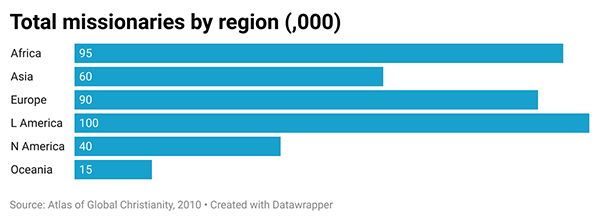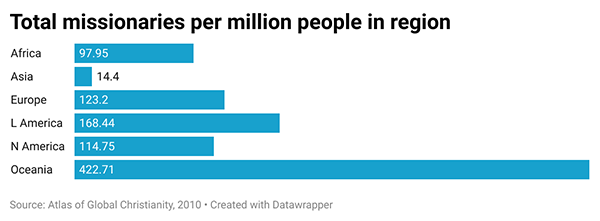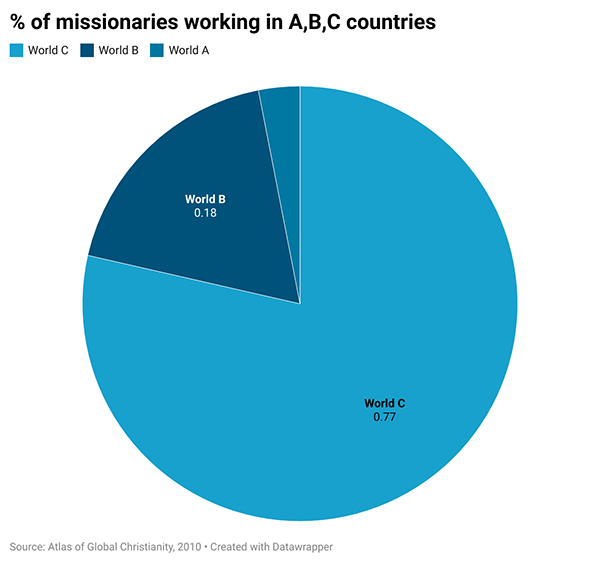Missionary Deployment
02 Jun 2023Updated: 2023 June 2
In the spring and fall, I frequently teach Lesson 9 of Perspectives. Whenever I do, the “Worldview Demonstration” is often a kind of audience participation feature that the hosts do either at the beginning of the session or at the middle break. Using coins and matchsticks (or some variant thereof), this presentation attempts to show people ‘visually’ the world’s population, the breakdown of religions, and how many of the world’s missionaries and the world’s mission money goes to the ‘more reached’ vs the ‘less reached.’
I am often inevitably asked how old the statistics are, and whether they have been updated. And the answer is, ‘fairly old’ and ‘sort of.’ In this brief essay, I’m going to explore some of the missionary numbers, why they are difficult to collect and analyze, and what the ‘current’ numbers might be.
To begin with, there are a few issues you have to understand about counting missionaries:
- Which traditions count? Depending on how you define them, there have been generally five Christian ‘traditions’ that missionaries can come out of: Anglican, Independent, Orthodox, Protestant or Roman Catholic. There have been, historically, two major sources of global missionary totals: Operation World and the World Christian Encyclopedia (WCE). The former has published primarily totals of P,I,A (Protestant, Independent, Anglican) missionaries, while the latter has published totals of all. For reasons I’ll discuss later, I generally use the broader WCE numbers.
- Length of service? This is also known as ‘short term’ vs. ‘long term’. Most missionary counts do not include people who go on 2-week short-term trips, but some include people who go for between 2 weeks and 2 years. Others only count those who “intend to be on the field 4 years or longer.”–but collecting how many are in that category can be challenging.
- Home vs Foreign Cross-Cultural. It is straight-forward to count an American or an Australian or an Austrian who serves in India. What about an Indian from, say, Uttar Pradesh who serves in Bihar? These two provinces are stupendously large, the languages can be vastly different, and the sociocultural distances can be immense. It can every bit as big a cross-cultural distance from Uttar Pradesh to Bihar as from America to Bihar, in terms of the complexity of mission. But does this count as ‘foreign’ or ‘cross-cultural mission’? For the most part, right now, one has to leave their passport country and go to a different country to be counted.
- Getting Reports. The actual process of gathering the data isn’t simple. There is no central repository to which all agencies report their information. No agency is required to report their total missionary numbers, let alone where they are deployed too. While some of the larger agencies are well known, at least in name, there are thousands of very small ‘mom-and-pop’ agencies—e.g. small non-profits with just a couple missionaries—whose work is never well known or counted.
- Security. Especially since the 2000 Operation World, security issues around the collection of missionary deployment data have grown. Even before 2000, there were some agencies that would say, for example, ‘Eastern Europe’ or ‘Middle East’ or ‘Asia—general’ without giving further details. This has increased significantly since 9⁄11.
For all of these reasons, it takes a significant amount of time and personal relationships to attempt to gather any sort of credible estimate of missionary numbers per country. Maintaining them over time—that is, looking for trends and ebbs and flows in missionary information—is even more difficult. Fortunately, we have two good, recent sources, both from the Center for the Study of Global Christianity. One is the 2010 Atlas of Global Christianity and the other is the latest World Christian Encyclopedia.
The total number of missionary workers globally is estimated by these sources at 425,000. (This number counts missionaries from all traditions—primarily Catholic and Protestant.)
What percentage of these workers are laboring among the unreached? That’s even more complicated.
If we are to use WCE numbers, we need to remember the WCE uses ‘unevangelized,’ not ‘unreached’ (see this article for clarification). The differences aren’t huge, but worth noting.
Any segment (country, province, language, people group, city, etc.) can be categorized as “World A” (unevangelized), World B (evangelized non-Christian) and World C (majority Christian). The rules are:
- A: <50% evangelized, based on the WCE formula/data.
- B: >=50% evangelized, <60% Christian.
- C: >=60% Christian, of any tradition.
We have missionary data by country. Every country is either in World A, B or C. The United States is a World C country; China is a World B country; Afghanistan is as World A country. However, within those countries, missionaries work with a great many different people, and the country hides a lot of this nuance. For example, China has many World A peoples (like the Uighurs), World B peoples (like the Han Chinese), and World C people groups (like the Lisu). So if several thousand missionaries were to work in China, those ‘several thousand’ would fall into the ‘World B’ column—from a country perspective. But some portion of those work amongst World A peoples, some amongst World B peoples, and some amongst World C peoples. The data that we have does not enable us to easily tell what those percentages are.
That said, it appears the vast majority of missionaries in any given country are likely working in peoples that are similar to the country itself – e.g. most of the missionaries in the United States probably work in World C people groups; most of those in India probably work in World B people groups.
The WCE is for sale, and I’m not going to give away data that is part of the book—not at the country level. With the approval of the WCE editors, I am giving global and regional totals. And here, at the end, is what you wanted all along.
Globally: 425,000 missionaries.
Some 77% of the missionary work force is almost certainly not focused on the unreached.
23% of the workforce is in places where ‘unreached’ and ‘evangelized’ peoples are largely found, but the ‘core’ of the workforce focused on the really difficult, most unreached peoples is probably not more than 3% of all missionaries.



